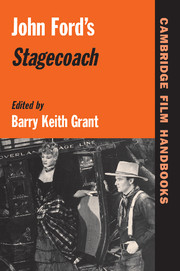Book contents
- Frontmatter
- Contents
- Acknowledgments and Credits
- List of Contributors
- Introduction: Spokes in the Wheels
- 1 Stagecoach and Hollywood's A-Western Renaissance
- 2 “Powered by a Ford”? Dudley Nichols, Authorship, and Cultural Ethos in Stagecoach
- 3 That Past, This Present: Historicizing John Ford, 1939
- 4 “A Little Bit Savage”: Stagecoach and Racial Representation
- 5 “Be a Proud, Glorified Dreg”: Class, Gender, and Frontier Democracy in Stagecoach
- 6 Stagecoach and the Quest for Selfhood
- Reviews of Stagecoach
- Filmography
- Select Bibliography
- Index
1 - Stagecoach and Hollywood's A-Western Renaissance
Published online by Cambridge University Press: 08 January 2010
- Frontmatter
- Contents
- Acknowledgments and Credits
- List of Contributors
- Introduction: Spokes in the Wheels
- 1 Stagecoach and Hollywood's A-Western Renaissance
- 2 “Powered by a Ford”? Dudley Nichols, Authorship, and Cultural Ethos in Stagecoach
- 3 That Past, This Present: Historicizing John Ford, 1939
- 4 “A Little Bit Savage”: Stagecoach and Racial Representation
- 5 “Be a Proud, Glorified Dreg”: Class, Gender, and Frontier Democracy in Stagecoach
- 6 Stagecoach and the Quest for Selfhood
- Reviews of Stagecoach
- Filmography
- Select Bibliography
- Index
Summary
“When the legend become fact,” the newspaper publisher famously opines in The Man Who Shot Liberty Valance (1962), “print the legend.” That sentiment certainly applies in the case of Stagecoach, which according to legend singlehandedly resuscitated the Western as a viable A-class Hollywood genre in 1939, elevating it to critical and aesthetic respectability in the process. That legend persists in many quarters, although it has been challenged for decades. More recently, in fact, critics and scholars have come to see Stagecoach in far more objective and complex terms with regard to changes not only in the Western at the time but also in the Hollywood film industry at large.
Among the historical facts about Stagecoach are these: First, the film was part of a fairly widespread resurgence of the Hollywood A-Western during the prewar era. Various estimates put the output of A-Westerns from 1939 through 1941 at about thirty, with the crop in 1939 also including Jesse James, Dodge City, Union Pacific, The Oklahoma Kid, Frontier Marshal, Stand Up and Fight, Man of Conquest, as well as Ford's own Drums Along the Mohawk. Second, this A-Western resurgence had less to do with the remarkable vitality of the B-Western at the time (then in its heyday, numbering well over one hundred per annum) than with the currency of other A-class production trends, cycles, and genres, from Technicolor spectacles and “outdoor” pictures to historical costume epics, biopics, swashbucklers, and Foreign Legion films.
- Type
- Chapter
- Information
- John Ford's Stagecoach , pp. 21 - 47Publisher: Cambridge University PressPrint publication year: 2002
- 1
- Cited by



